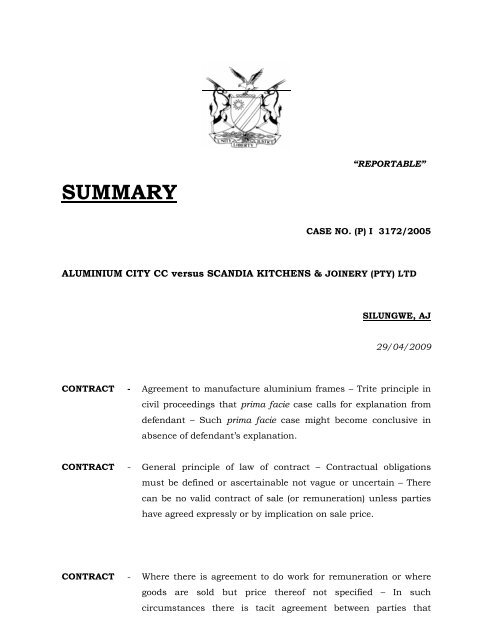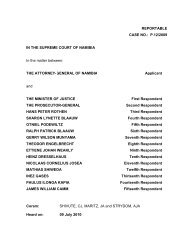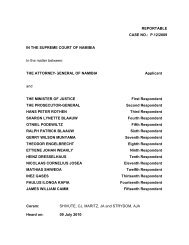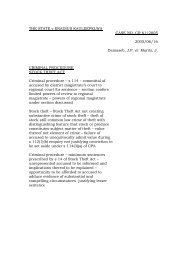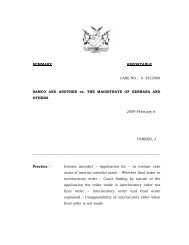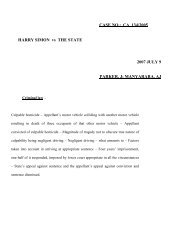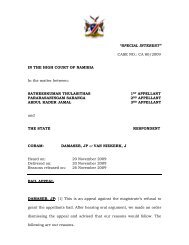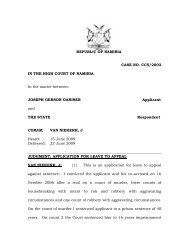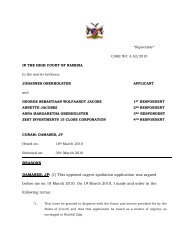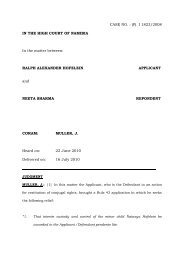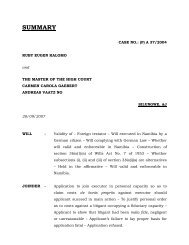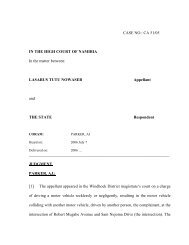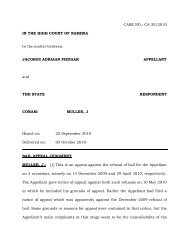ALUMINIUM CITY CC versus SCANDIA KITCHENS AND JOINERY ...
ALUMINIUM CITY CC versus SCANDIA KITCHENS AND JOINERY ...
ALUMINIUM CITY CC versus SCANDIA KITCHENS AND JOINERY ...
Create successful ePaper yourself
Turn your PDF publications into a flip-book with our unique Google optimized e-Paper software.
SUMMARY<br />
“REPORTABLE”<br />
CASE NO. (P) I 3172/2005<br />
<strong>ALUMINIUM</strong> <strong>CITY</strong> <strong>CC</strong> <strong>versus</strong> <strong>SC<strong>AND</strong>IA</strong> <strong>KITCHENS</strong> & <strong>JOINERY</strong> (PTY) LTD<br />
SILUNGWE, AJ<br />
29/04/2009<br />
CONTRACT - Agreement to manufacture aluminium frames – Trite principle in<br />
civil proceedings that prima facie case calls for explanation from<br />
defendant – Such prima facie case might become conclusive in<br />
absence of defendant’s explanation.<br />
CONTRACT - General principle of law of contract – Contractual obligations<br />
must be defined or ascertainable not vague or uncertain – There<br />
can be no valid contract of sale (or remuneration) unless parties<br />
have agreed expressly or by implication on sale price.<br />
CONTRACT - Where there is agreement to do work for remuneration or where<br />
goods are sold but price thereof not specified – In such<br />
circumstances there is tacit agreement between parties that
-2-<br />
amount of remuneration or price will be the contractor’s or<br />
supplier’s usual remuneration or price (or current or market<br />
price), etc.<br />
CONTRACT - An agreement, express or by implication, to pay a fair and<br />
reasonable price – Dependence on opinion evidence – Whether<br />
such expression of opinion renders contract of sale or<br />
remuneration cannot be regarded as judicially settled.
IN THE HIGH COURT OF NAMIBIA<br />
In the matter between:<br />
-3-<br />
CASE NO.: (P) I 3172/2005<br />
<strong>ALUMINIUM</strong> <strong>CITY</strong> <strong>CC</strong> Plaintiff<br />
and<br />
<strong>SC<strong>AND</strong>IA</strong> <strong>KITCHENS</strong> & <strong>JOINERY</strong> (PTY) LTD Defendant<br />
CORAM: SILUNGWE, AJ<br />
Heard on: 04/06/2007; 05/06/2007; 07/06/2007; 22/10/2007;<br />
23/10/2007; 24/10/2007; 25/10/2007; 26/10/2007;<br />
21/01/2008; 22/01/2008; 25/01/2008<br />
Delivered on: 2009/04/29<br />
JUDGMENT:<br />
SILUNGWE, AJ: [1] In this matter, the Plaintiff instituted an action<br />
against the defendant, claiming that a sum of N$319 399-84 was due and<br />
payable to it by virtue of a contract entered into between the parties during
-4-<br />
the period May to August 2005 in terms of which the plaintiff “manufactured,<br />
supplied and delivered 574 aluminium frames” to the defendant.<br />
[2] The plaintiff – a manufacturer and supplier of aluminium products,<br />
including aluminium frames – is a duly registered close corporation, whereas<br />
the defendant is a duly registered company with limited liability. These<br />
parties are represented by Advocates Corbett and Geier, respectively.<br />
[3] At the close of the case for the plaintiff, the defendant brought an<br />
application for absolution from the instance, pursuant to Rule 40(6) of the<br />
Rules of the Court. That application was, however, dismissed with costs, on<br />
the premises that there was prima facie evidence to show that -<br />
1. the plaintiff’s quotation of May 12, 2005, was not the basis of the agreement<br />
between the parties;<br />
2. the agreement between the parties had been concluded by virtue of the<br />
defendant’s presentation to the plaintiff of orders – Exhibits “B”, “C1”, “D” and<br />
“E” (which contained specifications of the aluminium frames to be<br />
manufactured) – and the oral acceptance thereof by the plaintiff; and<br />
3. the plaintiff charged the usual (or the current) prices for the (574)<br />
manufactured aluminium frames delivered to the defendant (as per calculations<br />
contained in Exhibit “K”).
-5-<br />
[4] It is trite law that a prima facie case in civil proceedings calls for an<br />
explanation from the defendant; and that if such an explanation is not<br />
forthcoming, the prima facie case might become conclusive (Venter v Credit<br />
Guarantee Insurance Corporation of South Africa Ltd 1996 (3) SA 966 (A) at<br />
980B). In casu, the defendant tendered evidence through its Director,<br />
Mr Christoph Haenisch and its other Director, Mr Johannes Dreyer, who was<br />
responsible for the defendants contracts, tendering, costing and human<br />
resources. It thus behoves the Court to decide whether the probabilities<br />
favour the version of the plaintiff or that of the defendant.<br />
[5] In my judgment, the dispute between the parties is to be decided with<br />
reference to two pivotal issues. The first issue is whether the contractual<br />
relationship between the parties was founded upon the plaintiff’s quotation to<br />
the defendant – Exhibit “A” – and the defendant’s acceptance thereof, as the<br />
defendant claims; or whether the said relationship stemmed from the<br />
defendant’s written orders – Exhibits “B1”, “C1”, “D” and “E” – and their<br />
acceptance by the plaintiff, as the plaintiff asserts? The second issue is<br />
whether, in the absence of agreed prices between the parties in respect of the<br />
aluminium frames that were manufactured by the Plaintiff, the determination<br />
of such prices was based on Exhibit “A” or, alternatively, on the plaintiff’s<br />
“usual” prices, alternatively, on “its fair and reasonable” prices?<br />
[6] Starting with the first issue, the prima facie evidence adduced on<br />
behalf of the plaintiff showed, as previously stated, that the plaintiff’s
-6-<br />
quotation – Exhibit “A” – was not the basis of the contractual relationship<br />
between the parties but that such relationship was consummated by virtue of<br />
the defendant’s presentation to the plaintiff of written orders – Exhibits “B1”,<br />
“C1”, “D”, and “E” – and the plaintiff’s oral acceptance thereof.<br />
[7] The facts set out hereunder are not in dispute.<br />
1. By arrangement between the parties, Mr Curschmann – a Director<br />
of the plaintiff, with a 90% member’s interest in the plaintiff – paid<br />
a visit to the defendant’s workshop on May 11, 2005, where he<br />
met with Mr Haenisch, the defendant’s director. Mr Haenisch then<br />
explained to Mr Curschmann the nature of the job on which the<br />
defendant wanted the plaintiff to furnish a quotation. The<br />
defendant required the plaintiff to manufacture aluminium frames<br />
to be fitted into metal frames which were to be mounted on study<br />
desks in respect of which the defendant had been awarded a<br />
tender by the Polytechnic of Namibia.<br />
2. Some of those study desks and steel frames into which the<br />
aluminium frames to be manufactured by the plaintiff would<br />
eventually be fitted were in the workshop and shown to<br />
Mr Curschmann who took measurements.<br />
3. As there would be variants and discrepancies in the sizes of the<br />
frames to be manufactured, it was agreed between Messrs
-7-<br />
Haenisch and Curschmann that the defendant would supply<br />
templates to the plaintiff containing precise measurements of the<br />
aluminium frames to be manufactured before the plaintiff would<br />
start to manufacture and supply the ordered frames.<br />
4. Mr Curschmann was then requested to furnish the defendant with<br />
a quotation on two different profiles which request was duly<br />
complied with by the next day, May 12. That quotation, which is<br />
now Exhibit “A”, bears Mr Curschmann’s handwritten inscription<br />
to the effect that prices shown thereon were “Net, excluding VAT”.<br />
5. Mr Haenisch communicated telephonically with Mr Dreyer, who<br />
was in Angola at the time, to discuss the plaintiff’s quotation with<br />
him. When Mr Haenisch mentioned the prices referred to in the<br />
quotation, Mr Dreyer made a mental calculation and came up with<br />
a total contract price – inclusive of VAT – of between N$220 000-<br />
00 and N$250 000-00. Consequently, he advised Mr Haenisch to<br />
accept, on the defendant’s behalf, the plaintiff’s quotation based<br />
on NKHS type of aluminium frames without glass.<br />
6. In consequence of the acceptance of the plaintiff’s quotation, the<br />
defendant commenced to order the first aluminium frames from<br />
the plaintiff, as per Exhibit “B1”, with other orders – Exhibits “C1”,<br />
“D” and “E” – following thereafter. Those orders in writing were
-8-<br />
accompanied by templates containing precise measurements in<br />
terms of paragraph (para) [7] 3, supra.<br />
7. On July 18, 2005, the plaintiff rendered to the defendant the first<br />
invoice – Exhibit “G”. This was followed by the second invoice<br />
dated August 30, 2005 – Exhibit “H”. Exhibits “G” and “H” covered<br />
all the written orders by the defendant.<br />
8. In response to a request by Mr Dreyer, towards the end of<br />
September, Mr Curschmann’s secretary sent a copy of the<br />
plaintiff’s quotation (Exhibit “A”) to him (Dreyer) by facsimile on<br />
September 29.<br />
9. Mr Dreyer then queried the correctness of the invoices rendered by<br />
the plaintiff to the defendant, namely, Exhibits “G” and “H”.<br />
10. On October 4, Mr Curschmann responded to Mr Dreyer’s request<br />
by supplying him with Exhibit “K” bearing his inscription in these<br />
terms: “Herewith the correct calculation as discussed this<br />
morning.”<br />
11. On October 10, Mr Dreyer faxed to Mr Curschmann a document<br />
that he later described in his evidence as a “comparison” of<br />
calculations – Exhibit “L2”. He claims that Exhibit “L2” was an<br />
endeavour to work out a specific price per square metre with
-9-<br />
reference to Exhibit “A”. Exhibit “L” shows a grand total of<br />
N$255 211-09, inclusive of VAT, which amount Mr Dreyer<br />
reckoned was due and payable to the plaintiff and which was paid<br />
into Court on June 6, 2006. With reference to the plaintiff’s claim,<br />
that payment left a balance of N$64 188-75 over which the parties<br />
have not been able to see eye to eye. It is the defendant’s alleged<br />
liability to pay the said balance to the plaintiff that is at the heart<br />
of the matter in these proceedings.<br />
[8] As Mr Haenisch properly conceded in evidence, there is no dispute that<br />
Exhibit “A” refers to only two sizes of frames, whereas Exhibit “K” refers to<br />
sixteen different sizes of frames, as evidenced by the defendant’s written<br />
orders (Exhibits “B1”, “C1”, “D” and “E”) upon which the plaintiff acted when<br />
it manufactured the 574 aluminium frames. Further, there is no dispute that<br />
the two sizes of frames referred to in Exhibit “A” do not correlate with any of<br />
the sixteen different sizes of frames manufactured by the plaintiff and<br />
delivered to the defendant. Indeed, no such reference to Exhibit “A” was ever<br />
made by the defendant in Exhibits “B1”, “C1”, “D” and “E”. Both Messrs<br />
Haenisch and Dreyer conceded to the effect that, ideally, it would have been<br />
proper to set out unit and total prices in the written orders. However, neither<br />
of them could explain why this was in fact not done in the present case. In<br />
my view, it is clear, on balance probabilities, that, in reality, the contractual<br />
relationship between the parties was not premised on Exhibit “A” but was in<br />
fact founded on Exhibits “B1”, “C1”, “D” and “E”.
-10-<br />
[9] Mr Curschmann’s testimony is that the irregular aluminium frames,<br />
each one of which had five sides, were more expensive to manufacture than<br />
the regular (rectangular) ones with four sides each, as the manufacture of the<br />
irregular sizes of frames involved the use of more labour and more hardware.<br />
Altogether, 434 irregular and 140 regular frames were manufactured by the<br />
plaintiff and supplied to the defendant.<br />
[10] In my evaluation of the evidence tendered by the parties, I am satisfied<br />
that the probabilities favour the plaintiff’s version, namely, that the basis of<br />
the parties’ contractual relationship is to be found, not in Exhibit “A” but in<br />
Exhibits “B1”, “C1”, “D” and “E”.<br />
[11] The second issue is whether, in the absence of agreed prices between<br />
the parties, the determination of prices for the aluminium frames produced<br />
by the plaintiff was based on the plaintiff’s “usual”, alternatively, “its fair and<br />
reasonable” prices? It is Mr Corbett’s submission that the plaintiff was<br />
entitled to charge its usual, or its fair and reasonable prices in the matter.<br />
This issue was previously canvassed when the application for absolution<br />
from the instance was made by the defendant. At that stage, the Court came<br />
to the conclusion that –<br />
With regard to the plaintiff’s first alternative, supra, and as Mr Corbett<br />
properly submits, the expression “its usual price” refers to a factual position<br />
which can be established by a non-expert witness, unlike the phraseology “a
-11-<br />
fair and reasonable price”, proof of which is dependant upon opinion evidence.<br />
See: Adcorp Spares PE (Pty) Ltd v Hydromulch Ltd 1972 (3) SA 663 (TPD) at<br />
668F-G; Shell SA (Pty) Ltd v Corbitt and Another 1986 (4) 523 (CPD) at 526G-<br />
H, 527B-D); Lombard v Pongola Sugar Milling Co. Ltd 1963 (4) SA 119 at<br />
128D-E.<br />
[12] It is a general principle of the law of contract that contractual<br />
obligations must be defined or ascertainable, not vague and uncertain. More<br />
specifically, there can be no valid contract of sale (or remuneration) unless<br />
the parties have agreed, either expressly or by implication upon a purchase<br />
price. They may do so by fixing the amount of the price in their contract or<br />
they may agree upon some external standard by the application whereof it<br />
will be possible to determine the price without further reference to them. See:<br />
Genac Properties JHB (Pty) Ltd v NBC Administrators <strong>CC</strong> 1992 (1) SA 566 (AD)<br />
at 576H-277A. Myburgh, J., put it thus, in the case of Adcorp Spares P.E Ltd<br />
v Hydromulch Ltd 1972 (3) SA 663 [T.P.D] at 668 E-G:<br />
“From the authorities it appears that the price if not specifically agreed must<br />
be determined by reference to something which in itself is certain. Such would<br />
be the market price of the merx if in fact it has a market price which is readily<br />
ascertainable. The same would apply to the usual price. An agreement to pay<br />
a fair and reasonable price, in my view, is too uncertain to give rise to a valid<br />
contract of sale. What is the meaning of a fair and reasonable price? Who<br />
must determine it? How is it to be calculated? These are all questions which<br />
in the ultimate result will depend on the opinion of some undetermined<br />
person or persons. What is to happen if they differ? The usual price refers to a<br />
factual position. That fact can be proved and is not like a fair and reasonable<br />
price dependant on opinion.”
-12-<br />
Whether or not the expression “a fair and reasonable” price (or a reasonable<br />
price) in a contract of sale or remuneration is invalid cannot, however, be<br />
regarded as judicially settled as the question still remains debatable. This<br />
question was raised but left undecided in Genac Properties JHB (Pty) Ltd v<br />
NBC Administrators <strong>CC</strong>, supra, at 577C-578D.<br />
[13] As a corollary to the first part of the preceding paragraph, the<br />
allegation by the plaintiff that, in the alternative, it charged a fair and<br />
reasonable price, particularly in the absence of an expert’s opinion evidence,<br />
is, in my view, flawed.<br />
[14] The only live issue in the matter, which can be established by non-<br />
opinion evidence, is whether the plaintiff was entitled to charge its usual<br />
prices, in view of the evidence led by the defendant. This begs the question<br />
whether such evidence challenges the plaintiff’s version that, since there was<br />
no reference to “a unit price” or “a total price” in the defendant’s written<br />
orders aforementioned, or in the delivery notes furnished by the plaintiff to<br />
the defendant when the frames were delivered, the plaintiff was entitled to<br />
charge its usual prices. Moreover, sight must not be lost of this Court’s<br />
finding on the defendant’s application for absolution from the instance that,<br />
in the absence of agreed prices between the parties, the plaintiff was, prima<br />
facie, entitled to charge its usual prices. Mr Corbett submits, and properly<br />
so, that the plaintiff’s version that it charged its usual prices has not been
-13-<br />
challenged through the defendant’s cross-examination of Mr Curschmann,<br />
who testified on behalf of the plaintiff, or through the evidence of its own<br />
witnesses.<br />
[15] It is not in dispute that, at the material time, the plaintiff had been in<br />
the business of manufacturing and supplying aluminium frames for more<br />
than ten years; that the plaintiff had previously done business with the<br />
defendant, though on a small scale, and that the plaintiff had not<br />
experienced any problems regarding payment; and further that, in this<br />
particular case, the prices charged by the plaintiff were worked out on the<br />
basis of the costs of materials, hardware and labour as well as on the basis of<br />
its markup.<br />
[16] Mr Curschmann’s testimony that 434 irregular, and 140 regular,<br />
frames had been manufactured by the plaintiff and delivered to the defendant<br />
was confirmed by Mr Haenisch, on behalf of the defendant. Mr<br />
Curschmann added that, since approximately three quarters of the total<br />
frames produced were of the irregular type, the net effect entailed the use of<br />
more labour, and more hardware. Mr Curschmann explained that the<br />
irregular frames were more expensive to manufacture than the regular<br />
frames due to the fact that the irregular frames had five sides each as<br />
opposed to the regular frames each of which had four sides only. The five<br />
joints on the corners of the irregular frames significantly accounted for the<br />
use of more labour, and more hardware. Hence, the smaller the frame, the
-14-<br />
more expensive it became. Mr Curschmann further explained that the cost of<br />
an irregular frame was N$288-80 while that of a regular frame was<br />
N$143-00. It is not in dispute that Exhibit “K” was compiled by<br />
Mr Curschmann at the defendant’s behest in order to explain how the<br />
plaintiff’s prices were arrived at. This Exhibit sets out the dimensions of the<br />
frames manufactured and supplied as well as the quantity thereof.<br />
[17] Mr Dreyer did not accept that Mr Curschmann’s method of calculating<br />
prices for the said aluminium frames, as reflected in Exhibit “K”, was correct,<br />
neither did he accept Mr Curschmann’s evidence that the smaller the frames,<br />
the more expensive they became. He maintained that, even though<br />
Mr Curschmann tried to distance himself from Exhibit “A”, the prices and<br />
calculations which appear on Exhibit “K” were based in part on prices and<br />
measurements found on Exhibit “A”. He thus maintained that the correct<br />
prices and calculations were to be derived from Exhibit “A”, as demonstrated<br />
by prices and calculations appearing in Exhibit “L2”. When this evidence is<br />
weighed against that given by Mr Curschmann on the plaintiff’s behalf, with<br />
particular reference to Exhibit “A”, I find myself unpersuaded by the<br />
defendant’s version.<br />
[18] As Exhibit “A” has previously been considered in this judgment and a<br />
finding made thereon, it is unnecessary to revisit the issue in any great<br />
detail. It is enough to reiterate the finding that Exhibit “A” was not, in reality,<br />
the basis of the contractual relationship that ultimately emerged between the
-15-<br />
parties since it is indisputable that the said exhibit refers to two different<br />
sizes of frames only; that no reference to that exhibit is made in any of the<br />
written orders – Exhibits “B1”, “C1”, “D” and “E” – which emanated from the<br />
defendant and which contain sixteen different sizes of frames that were in<br />
fact manufactured and delivered by the plaintiff to the defendant; that none<br />
of the sizes referred to in Exhibit “A” correlate with the different sizes of the<br />
sixteen frames that the plaintiff delivered to the defendant. It is thus self-<br />
evident that Exhibit “A” could certainly not have been the basis for<br />
determining prices of frames that were subsequently manufactured by the<br />
plaintiff. As previously stated, although Exhibit “A” contains unit prices, no<br />
such prices, let alone total prices, were ever mentioned in the defendant’s<br />
written orders aforesaid.<br />
[19] On the defendant’s own version, based on Mr Dreyer’s testimony, it<br />
anticipated, and accepted, an average cost of N$546-75 per frame.<br />
Mr Corbett argues that, according to Mr Dreyer’s calculations under cross-<br />
examination, the defendant would have had to pay N$313 447-05 (exclusive<br />
of VAT) for 574 frames; and a total of N$360 464-11 (inclusive of N$47 017-<br />
06 VAT). He further contends that, in reality, the defendant was charged an<br />
average price of N$483-87 per frame, in respect of the 574 frames, as Exhibit<br />
“K” shows. This figure is arrived at by dividing the invoiced price of<br />
N$277 738-99 by 574 frames. The result, so submits Mr Corbett, is that<br />
what the plaintiff charged for the frames was less, not more, than what the<br />
defendant had anticipated to pay. Mr Curschmann was resolute that what
-16-<br />
the plaintiff charged the defendant to pay for the 574 aluminium frames was<br />
based on the prices that the plaintiff usually charged for aluminium<br />
products. This, in my judgement, is a weighty submission against the<br />
defendant.<br />
[20] It is common cause in this matter that, although the production of the<br />
totality of 574 aluminium frames was not initially in the contemplation of the<br />
parties, that was in fact the quantity that the defendant ultimately requested<br />
the plaintiff to manufacture; and that the plaintiff produced the said frames<br />
and delivered them to the defendant. It is further common cause that there<br />
was no express agreement between the parties, either on the prices to be<br />
charged for the frames that were manufactured by the plaintiff and delivered<br />
to the defendant, or on the method of computing such prices.<br />
[21] It is a trite principle of law that, in order to form a valid and, therefore,<br />
an enforceable contract, a price must be fixed in such contract itself or that<br />
the price must be determinable by the application of some external standard<br />
on which the parties have agreed either expressly or by implication. See: R v<br />
Pearson 1942, EDL 117 at 121; R v Soller 1945 TPD 75; Lombard v Pongola<br />
Sugar Milling Co. Ltd 1963 (4) SA 119 at 128D-E; Adcorp Spares PE (Pty) Ltd v<br />
Hydromulch Ltd 1972 (3) SA 663 (TPD) at 667H-668A-H; Shell SA (Pty) Ltd v<br />
Corbitt and Another 1986 (4) SA 523 (CPD) at 525J-527A-I.
-17-<br />
[22] In Shell SA (Pty) Ltd v Corbitt and Another, supra, De Kock, J stated<br />
the following at 526E-257A-C:<br />
“They agreed on an external standard by the application of which it will be<br />
possible to determine the price without further reference to the parties<br />
themselves. Clause 3 provides as follows with regard to the price payable in<br />
respect of gas supplied by applicant to respondents:<br />
‘Prices according to Shell’s (ie applicant’s) latest price list ruling<br />
at time. Discounts as arranged.’<br />
By means of this clause the parties have, I consider, provided the machinery<br />
for ascertaining the price. They clearly contemplated sales at the applicant’s<br />
usual or normal or current price for gas from time to time. A term in a<br />
contract that the purchaser will pay the price normally charged by the seller,<br />
or the ruling market price, does not make the price uncertain or<br />
undeterminable. The price is regarded as sufficiently fixed if it can be<br />
ascertained with reference to an existing fact, such as the usual price of the<br />
article in a particular shop. The matter is put thus in De Wet and Yeats (op cit<br />
at 279):<br />
‘The price is ascertainable … it can be inferred from the<br />
circumstances that the parties had a specific price in mind<br />
such as when someone buys something without ascertaining<br />
the price, which happens so often when someone buys<br />
something in a shop. Without paying attention to the price. In<br />
such an instance the obvious assumption is that the thing has<br />
been bought for the price that is acceptable for such an article.<br />
(Free translation)<br />
This question was also discussed in R v Pearson 1942 EDL 117, where<br />
LANSDOWN JP said in his judgment at 121:<br />
‘There are many transactions in which goods pass on sale<br />
without a price being stated and the transaction is not the less<br />
a sale if the Court can determine from the conduct of the
-18-<br />
parties and the surrounding circumstances how the price was<br />
to be determined … In present-day custom a person often<br />
sends to a grocer shop a list of provisions to be supplied to his<br />
house and nothing is said about the price until at the end of<br />
the month the grocer renders an account. It would be futile to<br />
say that such a transaction was not a sale. It appears to me<br />
that in such a case there is a tacit agreement that the price is<br />
that at which the goods so supplied are usually sold by the<br />
grocer.’<br />
This decision was followed in R v Soller 1945 TPD 75, which confirmed that in<br />
such circumstances the parties impliedly agreed that the price to be paid was<br />
the seller’s usual price or, if he had no usual price, the current market price<br />
of the commodity. See further R v Levitas 1946 TPD 631; R v Kramer 1948 (3)<br />
SA 48 (N) at 52; R v Hasson 1953 (4) SA 269 (SR) at 271A and Lombard v<br />
Pongola Sugar Milling Co Ltd 1963 (4) SA 119 (D) at 128A and on appeal 1963<br />
(4) SA 860 (A) at 864B-C.<br />
It is therefore beyond dispute that parties can impliedly agree that the price<br />
shall be the supplier’s usual price or the current market price of the article in<br />
question.”<br />
[23] I fully associate myself with the observations made by De Kock, J, in<br />
Shell’s case, which I consider, by parity of reasoning, to be of application to<br />
the present matter. I am thus satisfied that, in all the circumstances of this<br />
case, the plaintiff was entitled to charge its usual prices for the aluminium<br />
frames. This finding evidently signifies, contrary to Mr Geier’s submission,<br />
that the parties’ versions are not mutually destructive, since the plaintiff’s<br />
version has not only carried the day, but has also served to discharge its<br />
onus of proof.
-19-<br />
[24] In the result, the following order is made:<br />
1. Judgment is given in favour of the plaintiff, with costs.<br />
2. As the sum of N$255 211-09 was paid into the Court on June 16,<br />
2006, the balance of N$64 188-75 is to be paid by the defendant<br />
to the plaintiff, with interest from November 4, 2005, the date of<br />
demand, to the date of this judgment.<br />
3. Interest on the sum of N$255 211-09 is to be paid by the<br />
defendant to the plaintiff with effect from November 4, 2005, the<br />
date of demand, to June 16, 2006, when that amount was paid<br />
into the Court.<br />
_____________________<br />
SILUNGWE, AJ
-20-<br />
COUNSEL ON BEHALF OF THE PLAINTIFF:<br />
Adv. Corbett<br />
Instructed by: Behrens & Pfeifer<br />
COUNSEL ON BEHALF OF THE DEFENDANT:<br />
Adv. Geier<br />
Instructed by: Francois Erasmus and Partners


